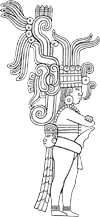

|
Death Gods, Smiling Faces and Colossal Heads: Archaeology of the Mexican Gulf Lowlands by Richard Diehl |
|
| |
Ancient Mexico was a mosaic of peoples, languages, and cultures, all with their unique but related art styles, living patterns, and religions. Of the major regions, none was more complex than the Gulf Lowlands, the area east of the Sierra Madre Oriental in modern Veracruz, Tabasco, Puebla, Queretaro, Hidalgo and San Luis Potosi states (Figure 1). However except for the world-renown Olmecs, these ancient cultures have not received the attention they deserve from the English-speaking public. Several reasons account for this but a primary one is that most of the research has been published in Spanish, frequently in limited access books and hard-to-find Mexican journals.
Death Gods, Smiling Faces, and Colossal Heads is my attempt to remedy this situation. After devoting a considerable part of the past 45 years to archaeological research in the region, I feel it is important to bring these rich and vibrant cultures to a broader audience than that typically reached by the books, journal articles and conference papers that have occupied me up until now. I hope to use the FAMSI web site to reach out to the public with short illustrated essays on many facets of these cultures. My scope will be as broad as possible, including archaeology, anthropology, geography, history, art, and other scholarly disciplines. I will examine every topic that occurs to me or is suggested by a reader. Since I am no an expert in all of the many facets of Gulf Lowland studies, I will submit drafts of my essays to people who are experts before posting them. However I do not always take advice, even good advice, and I remain responsible for any errors. As I advise my students, "Never take my word alone for anything, always check out alternative sources." I intend to add new materials to each section of Death Gods, Smiling Faces and Colossal Heads, on a regular basis, hopefully at the beginning of each month. Obviously numerous factors will influence this, including some that I cannot predict at this time. I hope you find these essays useful and enjoyable. Note: This chapter has be reprinted with permission. No reproduction of any part may take place without the written permission of Cambridge University Press. Table of Contents Pre-Columbian Cultures of the Gulf Coast |
|
|
Text links to all pages at this site are available at the FAMSI INDEX |
||
